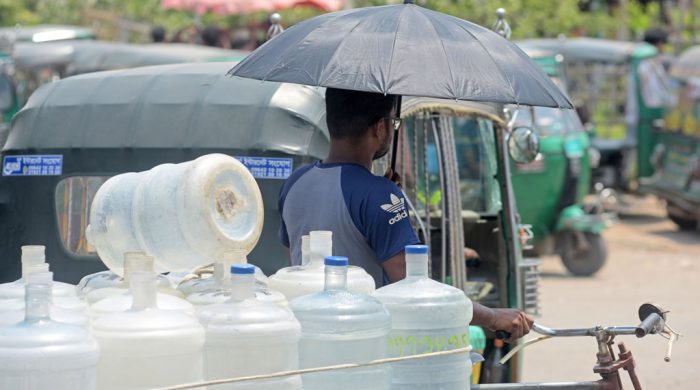Nor’wester kills 8, heatwave set to go

- Update Time : Monday, May 6, 2024
- 26 Time View

At least nine people were killed in storms in three districts between Saturday night and Sunday amid forecasts of an intense spell of nor’wester thrashing Bangladesh through Wednesday.
Weather forecasters warned people against going outside during nor’westers, also known as Kalboishakhi, as they are likely to bring damaging wind and hail.
The Bangladesh Meteorological Department issued a 72-hour Kalboishakhi alert at 4:00pm on Sunday, predicting thundershowers accompanied by squalls all over Bangladesh during the period.
‘People are advised to avoid going outside during storms,’ meteorologist Kazi Jebunnesa told New Age.
Nor’wester is caused when dry westerlies meet warm and moisture-prone southerlies blowing from the Bay of Bengal.
Nor’wester blows in a north-westerly direction between March and May, when the land surface temperature rapidly rises.
Until Sunday, an unprecedented heatwave continued for 36 days when day temperatures stayed at 40C or even more over vast swathes of Bangladesh for weeks, apparently supplying the energy needed for a powerful nor’wester to form.
The latest spell of nor’wester was supposed to bring relief from a blazing sun that killed thousands of poultry birds, potentially reduced crop production, and claimed at least 15 human lives according to the official account.
But the potential intensity of the storm raises worries, especially for the poor, who live in dilapidated housing conditions in hundreds of thousands, in cities and villages alike, and need to work outside for a livelihood.
New Age correspondent in Moulvibazar reported the death of a farmer by lightning at 2:30pm on Sunday.
The incident took place in the Kagabala union of Sadar upazila, and the deceased was identified as Abdul Hai, 45, who was busy harvesting paddy.
The north-eastern district of Habiganj was hit by an intense storm at around 3:00pm on Sunday. The storm, which continued for three hours, dumped tonnes of hail.
Over two lakh people remained without power for eight hours between 1:00am and 9:00am on Sunday as storms disrupted power supply in parts of Sylhet.
‘Fenchuganj and Dakkhin Surma areas were completely without power supply for eight hours,’ said Shah Jahurul Hossain, district relief and rehabilitation officer, Sylhet.
New Age correspondent in Khagrachari reported that a mother, Hasina Begum, 30, and her six-year-old son, Hanif Miah, were burned to death after their home caught fire from a lightning strike at 5:00am on Sunday.
A 50-year-old man, Bongjo Marma, 50, was killed by a lightning strike in Ramgarh on Saturday. Lightning also killed Sumita Tripura, 36, in Matiranga on Saturday.
Lightning also killed five livestock in Khagrachari between Saturday and Sunday.
New Age correspondent in Tangail reported the death of a cook, Wazed Ali Khan, 50, after he was struck by lightning while returning home after work around 11:00pm on Saturday.
Kishoreganj’s district relief and rehabilitation officer, Lutfor Rahman, confirmed the deaths of a pregnant woman, Rupa, 45, and her 5-year-old son Taijul, who were crushed under a tree uprooted by a nor’wester around 11:00pm on Saturday.
Lightning killed 10 people on May 2, the day a series of nor’westers hit Bangladesh after almost a month of dry and hot weather. On April 7, 13 people were killed by lightning or crushed under trees as a series of nor’wester thrashed coastal, southern, and south-western Bangladesh.
The United Nations Capital Development Fund, in a report, mentioned Bangladesh as a country with one of the highest death rates by lightning.
The BMD, in its weather bulletin issued at 6:00pm on Sunday, predicted rain in most places in the Mymensingh and Sylhet divisions today, in many places in the Dhaka and Chattogram divisions, and a few places over the rest of the country.
The day temperature might fall by 3C today.
The temperature drop might result in the ongoing heatwave disappearing from most of Bangladesh.
On Sunday, Bangladesh’s highest maximum temperature of 40.3C was recorded in Chuadanga as a mild to moderate heatwave swept the divisions of Dhaka, Rajshahi, Khulna, and Barishal.
The maximum day temperature in Dhaka was 36.7C.
In the 24 hours until 6:00pm on Sunday, Bangladesh’s highest rainfall of 83mm was recorded in Mymensingh, followed by 67mm rainfall recorded in Netrakona.
Citing rain forecasts over the next two days inside Bangladesh and upstream across the border in India, the Flood Forecasting and Warning Centre warned on Sunday afternoon that rivers in Sylhet, Sunamganj, Moulvibazar, Habiganj, Netrakona, and Kishoreganj districts might rapidly swell over the period.
The India Meteorological Department predicted widespread rainfall in areas in Bangladesh’s upstream region, such as Arunachal Pradesh, Assam, Meghalaya, Nagaland, Manipur, Mizoram, and Tripura, over the next seven days.
The rainfall might be accompanied by thunderstorms, lightning, and squalls rising to 60kmph, the IMD said, predicting isolated heavy to very heavy rainfall at certain places.

























